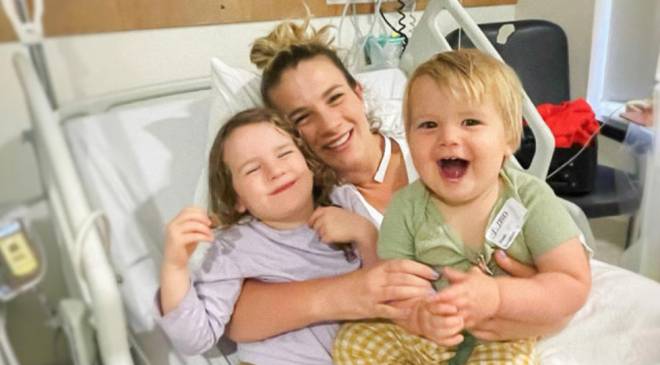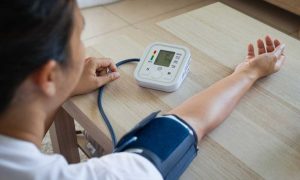Two years ago, I fell pregnant with a baby boy. Two years ago, I also developed an aggressive autoinflammatory disease that will be with me for life.
I’ve had 14 surgeries and more than 20 hospital admissions to date for my condition — juggling general anaesthetic and post-surgical pain with pregnancy, childbirth and breastfeeding.
Also Read– This big concept will change medicine
I’ve had MRIs with my face pressed up against the top of the tunnel, my upper half propped high to keep my pregnancy safe.
I’ve groggily read bedtime stories after a general anaesthetic more times than I can count.
I’ve pumped milk for my baby while hooked up to drug infusions.
I’ve navigated becoming immunosuppressed by my medications with two kids who bring home near-constant daycare illnesses.
I’ve had to explain to my young kids why I can’t chase them some days, and why I yelp when they touch me sometimes.
I’ve seen more than 10 specialists, spread across six hospitals. I’ve spent many thousands of dollars on specialists and surgery whilst juggling the reduced family income that comes with maternity leave and part-time work.
I’m not stating these facts for sympathy: There are tons of chronically ill and disabled parents in the world, and by and large — to borrow Eliza Hull’s term — “we’ve got this”.
But what I’ve rarely heard discussed is how difficult it is to navigate the maternity system with a chronic illness or invisible disability. And, conversely, to navigate parts of the mainstream health system as a pregnant woman and new mum.
At times, I’ve felt like an outsider in both systems. And I’m not alone
Researchers have found that women with disabilities, including non-visible disabilities such as chronic illness, are generally “an invisible population” among people giving birth.
Only a quarter of public maternity hospitals in Australia report adequate services for women with disabilities. Just 13 per cent have specialised training for staff in disability identification and referral pathways.
Also Read– 20 minutes, one resistance band and a chair for this seated arm workout
Given that nine per cent of women of childbearing age have a disability — and the average age of onset of my condition is 20 to 30, right in the childbearing years — this is a troubling oversight.
On the flip side, specialist doctors treating chronic illness can have limited knowledge around pregnant and breastfeeding patients.
The Royal Australasian College of Surgeons has no position statement on best practices for performing non-obstetric surgery on pregnant patients, and there’s currently no compulsory training requirement focused on breastfeeding knowledge for health professionals in Australia.
Does this all sound abstract? Let me tell you how it’s translated into reality for me
I’ve encountered doctors treating my chronic health condition with no apparent understanding of how to best accommodate my pregnancy or breastfeeding needs.
On the flip side, I’ve encountered obstetricians and maternity nurses who seemingly can’t, or won’t, look beyond my pregnancy to consider how chronic illness fits into the picture.
A prime example: being pregnant at the same time as developing a chronic illness made it incredibly hard to get my illness diagnosed.
The first sign of my Crohn’s disease — unbearable pelvic pain — was dismissed by one specialist as a stress-related pelvic floor issue. It’s a good thing I sought a second opinion: the pain turned out to be caused by a deep, infected abscess the size of an egg, requiring emergency surgery to head off the risk of a life-threatening septic infection.
Focused on my pregnancy, the specialist seemingly hadn’t considered non-gynaecological causes of my crippling pelvic pain.
On another occasion, later in my pregnancy, I woke up from general anaesthetic lying on my back — despite insisting on lying wedged on my side during the surgery due to the risks of back-sleeping in late pregnancy.
Focused on my digestive system, the surgical team seemingly hadn’t had my pregnancy at front of mind.
Throughout the blur of late pregnancy and early parenthood, I was prescribed heavy painkillers and months upon months of antibiotics.
Navigating conflicting advice on which medications I could safely take while pregnant and breastfeeding felt like some gestational form of Russian roulette. I researched late into the night, and ultimately followed advice from a specialist breastfeeding pharmacy line offered by Monash University.
The alternative — not taking antibiotics, in particular — could mean a fatal infection. What choice did I have?
Also Read– Why You Never Want to See These Four Letters on Your Boarding Pass
Most devastatingly of all, I lost my milk supply when a public hospital wouldn’t let my breastfeeding baby freely visit while I awaited surgery for a Crohn’s-related complication.
During that two-day emergency stay, the nurses also refused to lend me a breast pump. They said I could either stay in the hospital with engorged breasts — a risk factor for reduced milk supply and mastitis — or sign a form saying I’d discharged myself against medical advice and return in the morning. Shaken, I signed the form and went home to breastfeed my baby.
I returned to Emergency the next day for the surgery I needed. But it was too late: my body had stopped producing enough milk.
This was the greatest loss during my chronic illness journey as a new mum. Breastfeeding had been a lifeboat buoying my son and me through those nightmare early months after diagnosis. Those cosy 15 minutes snatched between doctor‘s appointments were key bonding moments.
I still think about how easy it would have been for the nurses to let my breastfeeding baby visit to feed on demand — especially since COVID visitor restrictions had eased at the time. But without sector-wide compulsory training on how to support breastfeeding for admitted patients, it felt all too easy for me to slip through the cracks.
A system not meant for new mothers like me
Almost 90 per cent of surgeons in Australia are men, with an average age of 50-plus.
So, more often than not, the doctors I’ve consulted about my Crohn’s disease have been older men.
Of course, practitioners vary, and I’ve seen good ones and not-so-good ones. But with few exceptions, it’s felt like the doctors have treated my questions about breastfeeding and pregnancy as “women’s business” to be decisively sidestepped.
I once made the mistake of crying in front of a surgeon after he’d told me I’d need repeated hospital admissions, separated from my young baby. He glowered at me in silence, finally asking, “Are you finished?”
And I’ll never forget cowering in a hospital recovery bed, clutching the sheets over my bare chest and breast pump as that esteemed surgeon stood over me days later, gruffly recounting how he’d discovered granulomas and ulcers throughout my body.
Sitting topless in a shared room, without a private place to pump or process the news, I felt sharply the sense of being vulnerably out of place, in a system that seemed not meant for new mothers like me.
Maternity services not built for the chronically ill
Read More:-Here’s How Telemarketers Keep Getting Your Number
Attending certain services for new mums, I’ve also felt subtly sidelined.
There was the parents’ group leader who opened the first session by asking the loaded question: “Who had a normal birth and who had an operation?”
Her comment unintentionally sidelined those of us whose bodies, for whatever reason, weren’t suited to a physiological birth. The fact that many caesareans are recommended for many women with pre-existing health conditions, like mine, apparently eluded her.
When I booked into sleep school with my baby, I couldn’t access the baths I need daily as part of managing my chronic condition. Kind nurses did their best to offer alternatives — small tubs I could try to submerge myself in — but it was just another reminder that most postpartum health services aren’t made for bodies like mine.
At mum-and-baby exercise classes, requesting adjustments for my chronic pain and recurrent surgeries was awkward. After being called out in front of others for my symptom-related lateness, I cancelled my membership, humiliated.
But when I tracked down more personalised exercise classes for those with special needs, the instructors couldn’t accommodate me bringing my baby. Again, trapped between the postpartum world and specialised disability services, I couldn’t find a place to belong.
I hope future chronically ill mothers have a different experience
I’ll need more surgeries for my disease, and I’ll continue on daily medication and fortnightly self-injections indefinitely.
I’ve adjusted to my new reality — kind of.
Soon after my diagnosis, I found a great gastroenterologist who acknowledges the illness’s profound impact on my daily life, and treats me as a whole person with multiple identities, including mother — not just a single body part. I’ve recently started seeing a new surgeon with an approachable bedside manner.
I’ve joined support groups for my disease, where I’m not the only mum juggling young kids.
Also Read– Why You Never Want to See These Four Letters on Your Boarding Pass
I’ve learned to hastily inject myself with my specialist drugs, in moments snatched between demands of my young kids. I’ve taught myself to smile through the stinging pain, wary of passing on my fear of needles to the little ones.
I’ve researched how to explain to my children that mum is sick — why she will always be sick — and why I’m not “better” after seeing the doctor.
I’ve bought books about different bodies, and disabilities. I’ve talked to them about how all bodies are different.
And there’s an upside to all this reading and talking. Yesterday, my three-year-old daughter announced she wants to be a doctor.
And if she does? I can only hope that maybe, one day, she’ll be the kind of doctor who makes this ordeal easier for chronically ill mothers like me.





































